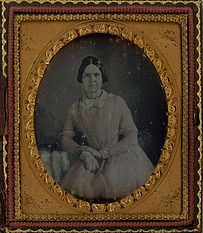American Daguerreotypes
The daguerreotype is the first technique used in the practice of photography. It is always unique, in that each image exists in only one copy. For this reason, daguerreotypes are highly valued. The daguerreotype image lies as if breathed onto the surface of the metal plate, it is not embedded in any material; it is extremely sharp and finely modulated, surprising us with the great detail of its half-tones. The fundamental recognizable character of the daguerreotype is its transfer from positive to negative through tilting it, allowing us at times to view even ourselves upon its surface.
The technique is named in honour of its inventor, the Frenchman Jacques-Louis-Mande Daguerre, who in collaboration with Niecephore Niepce who had previously announced presented details of the technique on 19 august 1839. In no time Daguerre published instructions and illustrations for the mastering of this process, which presented five basic operations: the preparation of silver-coated copper plates, the sensitizing of the plates with iodine vapours (later also bromide), the exposure, the development with mercury, and fixation. A short time later the introduction of gold toning was added, as well as occasional coloration by hand.
The daguerreotype image, which is created partially by an amalgam of silver, is extremely sensitive to any contact, and for this reason must be protected by a glass cover which cannot come in contact with the surface of the plate, and for this reason the plates were first enclosed in a metal passpartout. Everything was protected from the intrusion of dust with a seal along the edges and presented in a frame or decorated case. Quality presentation was an integrative part of the work.
The manner of creation of an image with the daguerreotype process differs from all other ordinary photographic processes. In light of the development of its display, the daguerreotype was closest to the tradition of painted miniature portraiture, in its presentation and in its composition, and photographs in their new capacity/quality as an image process. Daguerreotypes launched the photographic era, the "era of reproduction."





















